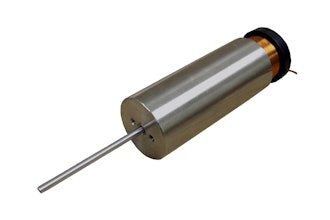
An automotive powertrain assembly manufacturer was looking to enhance the way it delivered components from its parts ‘supermarket’ to its work-in-process locations.
The company looked to Greer, SC-based Creform and its team of engineers to develop the right system. The customer was already using Creform AGVs for other applications within the plant and had several manual carts used in this application. A process and route change dictated adding automation and guidance for transport within the space-restrictive area.
Creform developed the design and assembly of both the vehicle and system controls. The bidirectional AGV built is a one vehicle system. It has three pickup points in the supermarket and 22 drop-off points throughout the operation. The AGV, used for auto-routing and safer handling, can travel between any two of the 22 locations based on an associate’s input. It operates 2-eight hour shifts per day.
The system also incorporates a powered conveyor deck that holds pallets of powertrain components. The AGV’s conveyor accepts the load from one side of the unit and dispenses from the other. Its pallet is approximately 24 x 24 in. (600 x 600 mm) and weighs up to 600 lb. (272 kg) for robust handling of powertrain components.
The bidirectional AGV, Creform drive unit model FH-B350090, is mounted to a customer steel frame for strength and durability. Each end of the AGV follows the guidepath independently to ensure accurate and repeatable tracking that is ideal in space restrictive areas and ensures alignment so that the conveyors smoothly and consistently transfer loads. The unit can travel with speeds up to 115 fpm (35m/min) and can carry a load capacity of up to 1984 lb. (900 kg)
The AGV is PLC controlled and features two HMI touch screens that an associate can swivel to ensure access in space restrictive areas. A custom course-control program was created for this application and the AGV uses floor positioned RFID tags for routing, speed changes and obstacle sensor view changes. The system also uses a peel and stick magnetic tape guidepath that is easily and quickly installed, changed or repaired. This application uses an approximate 200-feet of guide path and the route is L-shaped. Magnetic tape commands are placed adjacent to the guidepath for stopping.
The power pack is a 24-volt system powered by two batteries, 12V, 100AH, AGM with side-mounted opportunity charging to automatically maintain peak performance battery levels. There is no need to cut into floor for charging plates, so the system proved less expensive to install and provided more flexibility for repositioning. When the drive wheels are elevated, with powered engage/disengage, the AGV can be easily repositioned by an associate.
The AGV features complete safety equipment for compliance to safety category 3. Safety equipment includes: laser obstacle scanners front and rear with 16 settable zones; E-stop buttons at each end of the AGV; and safety light and audible warning. The unit features ‘photo eyes’ for conveyor control and to detect an unexpected load shift during transport. Manually actuated load safety stops are pushed down for load transfers to offboard conveyor stations. These simple but effective spring-loaded mechanisms ensure loads are held securely aboard the AGV during travel.
The Creform System is used to create an array of material handling and efficiency enhancing devices and is a proven component in continuous improvement and Lean Manufacturing programs. The company partners with customers in developing and implementing these programs.
www.creform.com; 800-839-8823






















